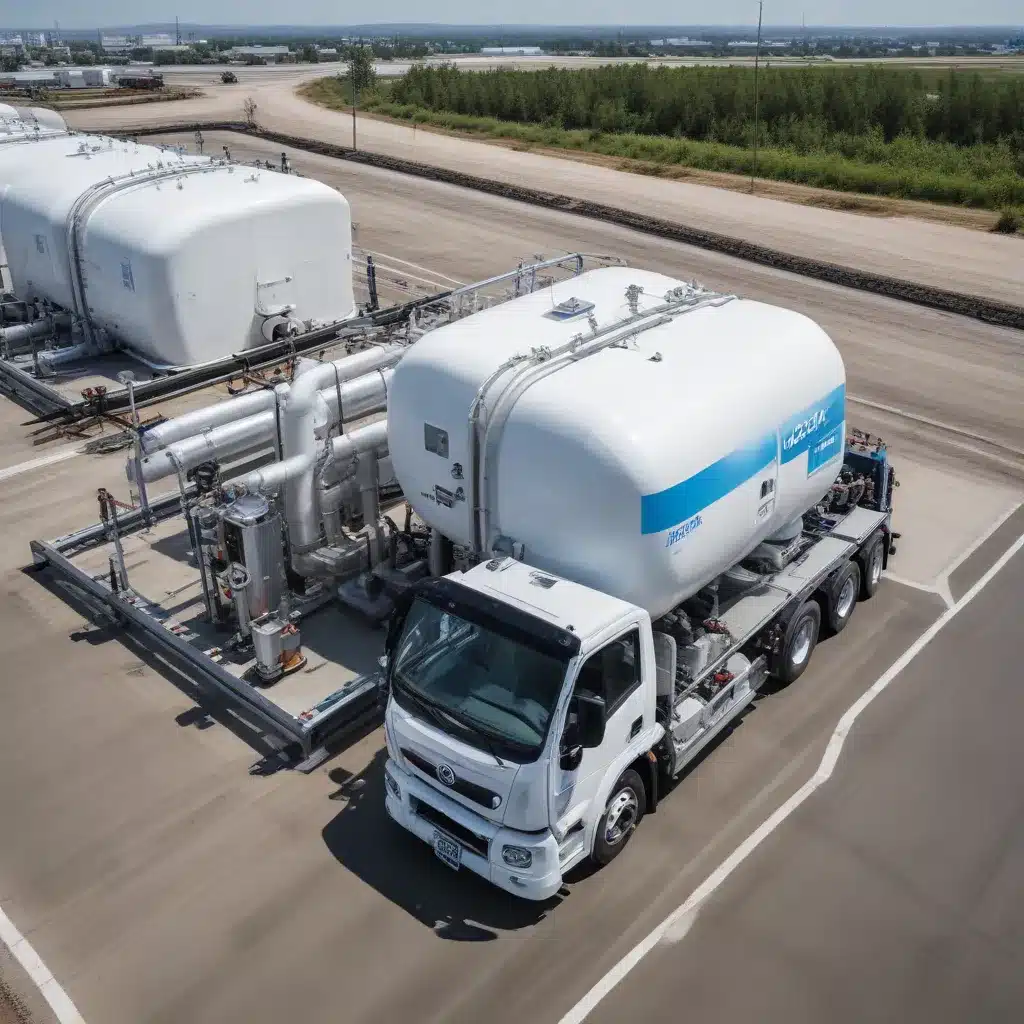
As the world accelerates its transition to a sustainable energy future, hydrogen has emerged as a pivotal player in decarbonizing the most challenging sectors of the economy. This versatile energy carrier holds the promise to revolutionize how we produce, store, and consume power, ushering in a new era of environmental responsibility across Europe.
Hydrogen’s Industrial Applications
Hydrogen’s remarkable properties make it a valuable asset in addressing the energy needs of hard-to-abate industries. In the transportation sector, fuel cell vehicles offer a zero-emission alternative to traditional internal combustion engines, emitting only water vapor as a byproduct. This technology has the potential to transform the way we move goods and people, particularly in heavy-duty applications like buses, trucks, and the maritime industry.
Beyond transportation, hydrogen’s impact extends to the industrial realm. In steel production, the traditional carbon-intensive methods can be replaced by hydrogen direct reduction, significantly reducing emissions. Similarly, in the cement industry, hydrogen can be utilized as a fuel source, lowering the carbon footprint of this energy-intensive process. Tailoring hydrogen applications to the specific needs of various industries, such as dedicated fuel cell systems and optimized combustion technologies, will be crucial in driving widespread adoption.
Hydrogen Production Methods
The production of clean, low-carbon hydrogen is a crucial component of its broader integration into the energy system. Electrolysis, the process of splitting water molecules using renewable electricity, has emerged as a promising pathway, particularly when coupled with abundant wind and solar resources. Advancements in electrolyzer technology, including improved efficiency, cost-effectiveness, and integration with variable renewable sources, are pivotal in unlocking the full potential of this approach.
Another established method, steam methane reforming, relies on the reaction between natural gas and high-temperature steam to produce hydrogen. While this process is widely used, efforts are underway to integrate carbon capture and storage technologies to mitigate the associated emissions. Additionally, innovative approaches, such as biohydrogen generation through the use of microorganisms, offer further opportunities to diversify the hydrogen production landscape.
Hydrogen Infrastructure Development
The successful integration of hydrogen into the energy system hinges on the development of a robust and accessible infrastructure. This includes the construction of hydrogen fueling stations to support the growing fleet of fuel cell vehicles, as well as the expansion of pipelines and distribution networks to facilitate the transportation and storage of this energy carrier.
Recognizing the importance of this infrastructure, governments and private entities are collaborating to drive the necessary investments. For example, the European Union’s Hydrogen Strategy outlines plans to build a comprehensive hydrogen ecosystem, including the deployment of 40 gigawatts of renewable hydrogen electrolyzers by 2030.
Hydrogen Safety and Regulations
The widespread adoption of hydrogen technology requires a strong emphasis on safety and the establishment of clear regulatory frameworks. Safety protocols for the production, storage, and transportation of hydrogen are crucial to mitigate risks and ensure public trust. Ongoing collaboration between policymakers, industry stakeholders, and research institutions is essential in developing comprehensive regulatory frameworks that address safety concerns while enabling the seamless integration of hydrogen into the energy system.
Environmental Impact of Hydrogen
One of the primary drivers behind the push for hydrogen is its potential to significantly reduce greenhouse gas emissions. When produced using renewable energy sources, hydrogen can be considered a zero-emission fuel, as the only byproduct of the electrochemical reaction is water. This makes it a valuable tool in the fight against climate change, especially in sectors where electrification alone may not be sufficient.
Moreover, hydrogen’s versatility extends to its ability to be integrated into other sustainable energy solutions, such as the production of synthetic fuels and the storage of renewable energy. By coupling hydrogen with carbon capture and utilization technologies, the creation of circular carbon fuels can help close the loop on emissions, further enhancing the environmental benefits of this energy carrier.
Hydrogen’s Economic Potential
As the demand for clean energy solutions continues to grow, the economic potential of hydrogen is gaining increasing attention. Advancements in production methods, coupled with supportive policy frameworks and targeted investments, are driving down the costs associated with hydrogen technology. This improving cost competitiveness is opening the door to a wider range of commercial and industrial applications, creating new market opportunities and fostering innovation.
Recognizing the strategic importance of hydrogen, governments and private entities are collaborating to develop dedicated hydrogen hubs and innovation centers. These collaborative initiatives aim to accelerate the development and deployment of hydrogen technologies, while also addressing infrastructure challenges and fostering cross-industry synergies.
Technological Advancements in Hydrogen
Ongoing research and innovation are crucial in unlocking the full potential of hydrogen. Improvements in hydrogen storage solutions, such as the development of high-density storage materials and efficient compression techniques, can enhance the transportation and long-term viability of this energy carrier. Furthermore, advancements in hydrogen conversion efficiency, particularly in fuel cells and electrolyzers, are driving down the costs and increasing the performance of hydrogen-based systems.
Hydrogen’s Role in Decarbonization
As Europe strives to achieve its ambitious net-zero emissions goals, hydrogen emerges as a vital component of the decarbonization strategy. By integrating hydrogen across various sectors, from transportation and industry to power generation and energy storage, the continent can make significant strides in reducing its carbon footprint. The versatility of hydrogen allows for a multifaceted approach, where it can substitute fossil fuels, facilitate the integration of renewable energy, and enable the development of innovative emission mitigation technologies.
The journey towards a sustainable, hydrogen-powered future is well underway, with governments, industry leaders, and research institutions collaborating to unlock the vast potential of this transformative energy carrier. As the European Future Energy Forum continues to showcase the latest advancements and explore the opportunities in the hydrogen space, the path to a cleaner, more resilient energy system becomes ever more clear.







